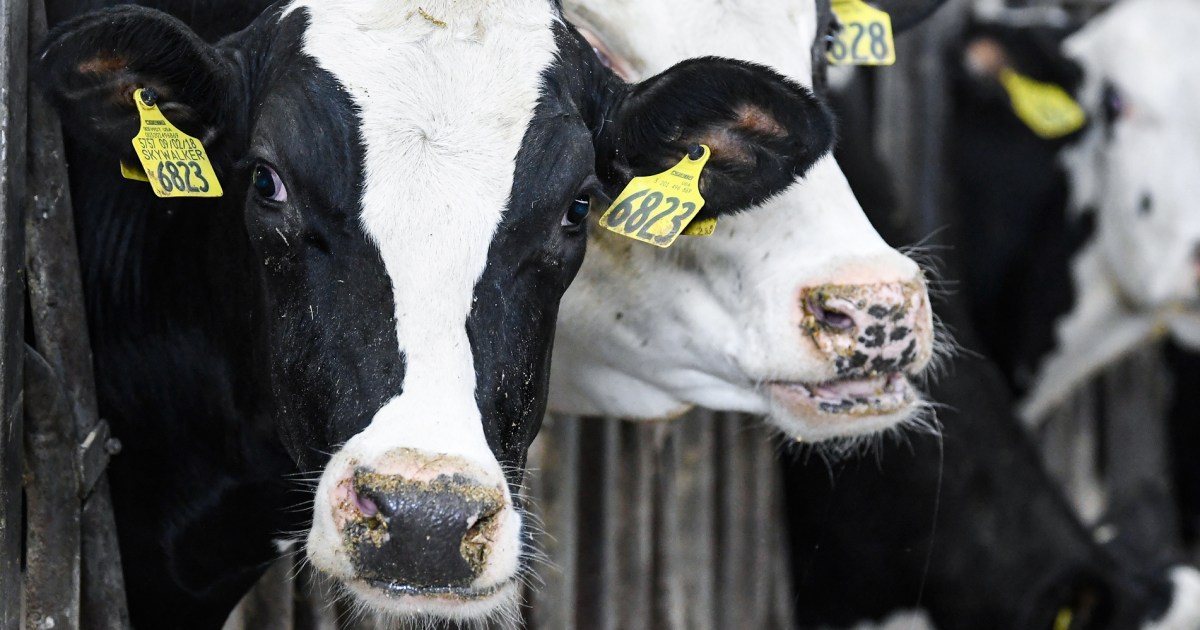
The Summary
- A new study describes how bird flu has spread between dairy cows and from cows to other mammals.
- Experts worry the virus is developing new capabilities that could help it evolve to spread from person to person — something that has not yet been observed.
- According to the new research, cats and a raccoon acquired the virus and died, most likely after drinking raw milk.
New research into the ongoing bird flu outbreaks on dairy farms describes in unprecedented detail how efficiently the virus has spread among cows, and from cows to other mammals, including cats and a raccoon.
It’s an indication that the virus is developing new capabilities that have bird flu experts worried.
Bird flu has affected more than 100 million wild aquatic birds, commercial flocks and backyard poultry in the U.S. over the last several years. Its spread has had scientists on alert about the possibility that the virus could one day evolve to spread from person to person, igniting the next pandemic.
No human-to-human transmission has occurred yet, as far as researchers know. But the case total among people continues to grow: Colorado state health officials confirmed three new cases of bird flu in people Thursday, bringing the national total to 14.
The human cases have all been in farmworkers infected after exposure to sick animals, and all but one have been diagnosed in the last four months. Though little is known yet about the three newest infections, the rest have been mild.
The new study demonstrates that the virus is spreading from one mammal species to another — a relatively new phenomenon that could make it harder for authorities to control.
The longer the virus remains uncontrolled, the more potential it has to evolve and adapt to become more of a threat to people, according to the authors of the new study, which was published in the journal Nature on Tuesday.
“The virus is not very efficient in infecting humans and transmitting between humans, but if the virus continues to circulate in dairy cows and from dairy cows into other mammalian species, that could change,” said Diego Diel, an author of the study and the director of the Virology Laboratory at the Animal Health Diagnostic Center at Cornell University. “It’s concerning.”
The new study evaluated the first outbreaks of avian influenza among cows at nine farms in Texas, New Mexico, Kansas and Ohio, sampling the animals and then comparing the genetic similarity of virus between them.
The researchers found that the virus, a particular strain of bird flu known as H5N1, spread rapidly among farms. When infected cows were moved from Texas to a different farm in Ohio, the virus was soon discovered in the Ohio cows. And genetic sequencing suggests that cats and a raccoon acquired the virus and died, most likely after drinking raw milk.
Sick cows began to eat less feed, ruminated less, experienced decreased milk production and produced discolored milk, the study says. On some affected farms, cows died at twice the normal rate.
Andrew Bowman, a professor of veterinary preventive medicine at Ohio State University who was not involved in the new study, said the research reflects the experience veterinarians have had on many U.S. farms.
“It matches with the clinical picture,” Bowman said. “That’s 100% what we’ve seen on dairy farms. This is just the first real published documentation.”
The study bolsters evidence that handling or drinking unpasteurized milk is dangerous.
Diel said infected cows shed incredible amounts of virus through their mammary glands when infected — at higher concentrations than the virus can be easily cultured in a laboratory setting.
“It’s extremely risky to drink raw milk,” Diel said.
Various studies have detected live H5N1 virus in raw milk, and others have shown that pasteurization inactivates the virus, making commercially produced milk safe for consumption.
Farmers are not supposed to send any milk with a possibility of contamination for production.
“Milk from sick cows shouldn’t be going into the milk supply,” Bowman said.
As scientists continue to study the avian flu outbreak, Bowman said he will be interested to learn whether cows can shed the virus before they start to appear sick, as well as whether the virus continues to spread onward from the mammals that contract infections from cows.
This is the third episode in which the virus has spread fairly quickly among a group of mammals, said Anice Lowen, a virologist and professor at Emory University School of Medicine who was also not involved in the new study. Previously, virus spread on mink farms and among sea lions and fur seals last summer.
Cases in some mammals have been severe, and the virus has caused mass deaths among sea lions and seals, among other species.
Lowen said health officials should also consider the risk that people could get infected with H5N1 and the seasonal flu at the same time this winter. When someone is infected by multiple influenza viruses, those viruses can go through a process called reassortment, in which they trade genetic information.
This process can give viruses a shortcut to evolve, potentially altering the way they spread.
“The virus we have right now in cows presents a relatively low risk to humans. CDC has said that and they’re right,” Lowen said. “But where the risk lies in my mind is viral evolution. They change when they adapt to new hosts. They change when they go through reassortment and exchange genes.”
The Centers for Disease Control and Prevention declined to comment on the new research.






